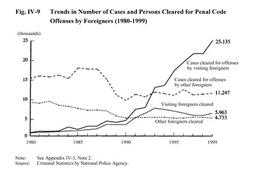| Previous Next Index Image Index Year Selection | |
|
|
1 Trends in penal code offenses by foreigners Criminal Statistics by National Police Agency show trends since 1980in the numbers of cases and persons cleared for penal code offenses allegedly committed by foreigners, other than traffic professional negligence(here referred to as"cases cleared for penal code offenses"and"persons cleared for penal code offenses"). After peaking at20,156in1986,the number of cases cleared for penal code offenses decreased to13,410in1990. But it turned up in1991and reached36,382in1999,up by3,679(11.2%)from the previous year. The number of persons cleared for penal code offenses was in a downward trend from1993but increased by448(4.4%)from the previous year to10,696in1999(see Appendix IV-3 ). The share of foreigners in the total number of persons cleared for penal code offenses in Japan rose from2.5%in1980and peaked at4.1%in1993. Following a slight decline, it rose0.2%from the previous year to3.4%in1999.
Fig. IV-9 shows the numbers of cases and persons cleared for penal code offenses allegedly committed by visiting foreigners(based on the definition in Criminal Statistics by National Police Agency, this refers to all foreigners staying in Japan except for permanent residents and other so-called fixed residents, those connected with U. S. forces serving in Japan, and those whose status is unknown)and by other foreigners. Fig. IV-9 Trends in Number of Cases and Persons Cleared for Penal Code Offenses by Foreigners(1980-1999) In1980,782visiting foreigners were cleared for penal code offenses in867cases. The two figures have both increased since then;the number of cases reached25,135in1999(up15.9%from the previous year), about29times as large as in1980. Although the number of visiting foreigners cleared decreased momentarily after reaching a record high of7,276in1993,it rose10.8%from the previous year in1999(581persons cleared).By offense, visiting foreigners were most frequently cleared for larceny in1999,with3,404persons cleared(57.1%), followed by embezzlement of lost property with1,214persons(20.4%), robbery with278persons(4.7%), bodily injury with224persons(3.8%)and counterfeit with186persons(3.1%). |
